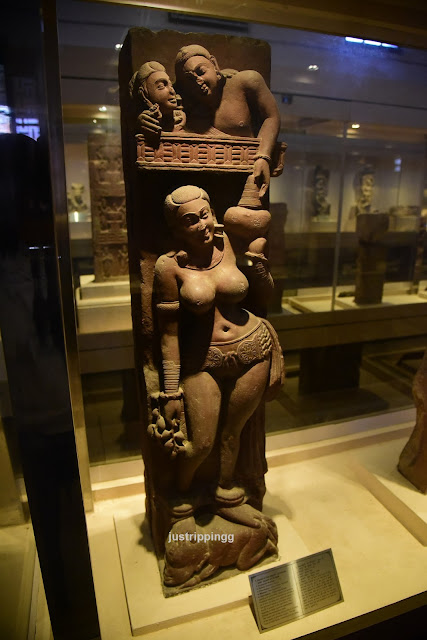The Mathura Museum is like a candy store for kids who want a sugar rush. And for a newly minted imagehead like you, this is like a time portal where within few hours you can have an idea how iconography evolved over the past two thousand years from depiction of Mother Goddess in the Copper Age to the most scintillating Surya. You have not seen a better and more endowed museum in the country. And you are not even referring to the well-endowed resident Shalbhanjikas.
Mathura as a city is as old as history. Dynasties have come and gone leaving their signs behind over the centuries. Some great archaeological efforts by stalwarts like Cunningham and the commissioning of the museum by Mathura Collector FS Growse has ensured that extensive excavations have been done in Mathura area and the finds lovingly displayed here.
 |
| Salbhanjika from Bhuteshwar Mound in Mathura |
There is so much to see here in the sculpture gallery, that it could take a week if you want to go over each exhibit, understand it, get a hang of the flow of time and dynasties and the evolution of style and iconography. And of course, these exhibits are further proof that North India was teeming with temples once upon a time, say, just like Odisha or Karnataka.
This brief post serves as the second part of the post you did on the Three Yakshis of Mathura that were taken to Calcutta’s Indian Museum by Cunningham.
Just like at Sanchi (few in-situ Salbhanjikas on the four torans) and Bharhut (the Stup Complex has been moved to Indian Museum), Mathura saw huge number of Salbhanjikas depicted on the Stupa complexes excavated in the Mathura and neighbouring areas. In the Mathura Museum there is a whole section dedicated to these ladies. Though the exhibits are encased in glass and photographing them takes real effort.
So, the post
will not have much prose – it will be all photos of the lovely ladies.
There were Six Bhutesvara
Shalabhanjikas of the Kushan period. Three are in Indian Musuem and three are in Mathura.
 |
| The Five Shalbhanjikas in Mathura during Growse time - the sixth one was already in Calcutta - two more (2nd and 4th) will be sent to Calcutta |
Here the Shalabhanjika holds grapes in her right hand and raises a goblet of the finished product to the amorous couple on the top.
The lady here is putting on her saree or skirt. It is Saturday night and a new discotheque has opened in town and she has all the intent on painting the town red tonite.
Going through
your folder, you are disappointed that you missed clicking the third one. But
it is okay - there is no way you will be able to see all that is exhibited in
the museum in one go.
Here are the three ladies in the photo from Wiki
Now this is a different looking stone piece. This is a bracket part of a gateway found from Sonkh Tila in Govardhan dated 100 CE. The sculpture here to you looks more realistic. The sculptor has slightly reduced the voluptuosness making the shalbhanjika more real-life and that charming and desirable. The Serpent Hood in her anklet means she belongs to the Naga family.
A Beautiful
Description of a Salabhanjika exhibited in New York’s Met Museum
Tree Spirit Deity (Yakshi)1st–2nd century
India (Uttar Pradesh, Mathura region)
On view at The Met Fifth Avenue in Gallery 235
This double-sided bracket (vrksadevata) for a gateway (torana) is decorated on either side with a tree-spirit deity known as a yakshi, who holds a flowering tree as a symbol of her fecundity. Her pose is that of salabhanjika ("breaking a branch of the sala tree"): grasping a branch, she thus engages with the fertility of the earth, bringing the tree into flower. Such figures provided an auspicious presence at the entrance to a sacred site.
Another sculpture from Bhuteshwar Mound - not part of the Group 6
Why are you not taking my calls?
Check your log, I have called you like 50 times since
yesterday
I have been texting you – I can see you received the
whatsapp messages – but why are you not reading them? Have you changed the
settings? If you have read them why are the double ticks not blue?
Why are you so busy?
And who is that woman in the background? I can hear
someone.
Your sister!
But you don’t have a sister!
Cousin sister?
Don’t lie to me.
Tell me now - where are you? I am coming over right now. I have had enough of you
Most women are nice. This one is jealous, obsessive, paranoid and psychotic with undiagnosed bipolar disorder.
Darpan-Dharini or is it Mobile-Dharini, Kushan, Maholi Village now being a nuisance in Mathura Museum
Usually the Shalbhanjika is shown coyly standing under the branches of a tree holding the branches. But then if you have Vitamin B12 Deficiency, holding the branches with your arms is a pain as it results in cramps, a medical condition called Pernicious Anemia. So, while the yakshi is put on a diet of proteins and milk, she has a job to do.
In such circumstances, the Yakshi kicks the trunk of the tree resulting in the tree growing leaves and flowering. This is called Ashoka-Dhohada. You are not sure if only the Ashoka trees get this preferential treatment at the hands…er…foot of Salbhanjika.
Ashoka-Dhohada, Kushan
Period, Provenance – Manoharpura, Mathura, now glass encased at Mathura Muesum
References
Centre for Art
and Archaeology
The Six Bhutesvara Yakshis
https://en.wikipedia.org/wiki/Bhutesvara_Yakshis
Mathura – A District Memoir by F. S. Growse
Related Posts in this Blog








AWESOME POST THANKS FOR SHARE I LOVE THIS POST
ReplyDeleteThanks much Lovesov!
Delete